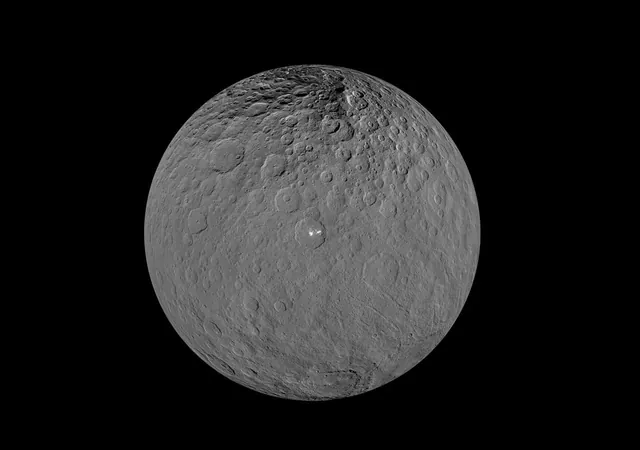
Shocking Discovery on Ceres: Evidence of a Past Ocean and Potential Life!
2024-09-26
Introduction
Dwarf planet Ceres, the largest object in the asteroid belt, has captivated scientists with its mysterious features and potential for harboring life. Since NASA's Dawn mission arrived in 2015, researchers have gradually uncovered Ceres' intriguing secrets, revealing a world that could have once been covered by an ocean.
Recent Findings
In a groundbreaking study published in Science Advances, new research suggests that Ceres might not only have been an oceanic world, but it also contains long-chain aliphatic organics (AOs)—key ingredients that may hint at the possibility of life.
Geological Activity
Ceres has proven to be a geologically active environment, with the presence of AOs indicating recent geological processes. These long chains of hydrocarbons, essential components of natural fats, may have formed within the dwarf planet itself and surfaced through cryovolcanic activity.
Implications of AOs
This raises the exciting possibility that these organics are not simply remnants dropped by meteorite impacts but are instead indicative of a more complex internal composition. Before this study, the presence of AOs on Ceres was well-documented, but the origins of these compounds remained uncertain.
Historical Context
The discovery that they likely formed from Ceres’ subsurface ocean instead of being deposited by external sources strengthens the hypothesis that Ceres once held a global ocean similar to the ones found on other icy moons, such as Enceladus and Europa.
Conditions for Life
Ceres’ conditions may have been conducive to life in the past, especially considering the combination of clays, carbonates, and briny water detected on its surface.
Expert Insights
Maria Cristina De Sanctis, a planetary scientist from Italy, highlights this significance, stating, "The high quantity of AOs and their spectral similarities to terrestrial kerogens, which contain organic remains, increase Ceres' potential habitability."
Chemical Lifecycle of AOs
The chemical lifecycle of AOs also tells an intriguing story. As these organics degrade relatively quickly—within about 10 million years—the presence of AOs on Ceres suggests that they formed relatively recently in geological terms.
Research Methodology
By simulating Ceres-like conditions in a laboratory, researchers confirmed that these compounds progressively surfaced from deeper layers, indicating a dynamic geological history.
Conclusion
Ceres is unlike any other body in the asteroid belt, leading scientists to believe it may have originated farther out in the solar system. Its unique features and historical presence of liquid water are fueling speculation that the dwarf planet could be a treasure trove of information about the formation of worlds and the potential for life beyond Earth.
Future Prospects
The revelations from the Dawn mission continue to transform our understanding of Ceres and its potential. With the mysteries of this small celestial body slowly unraveling, it's clear that Ceres deserves a closer examination in future missions.
Call to Action
What other secrets lurk beneath its icy shell? As research progresses, the prospect of future discoveries on Ceres shines brightly on the horizon, beckoning scientists—and us—to learn even more about the strange and intriguing worlds within our solar system. Stay tuned for further groundbreaking discoveries that could change everything we know about life's possibilities beyond our planet!



 Brasil (PT)
Brasil (PT)
 Canada (EN)
Canada (EN)
 Chile (ES)
Chile (ES)
 España (ES)
España (ES)
 France (FR)
France (FR)
 Hong Kong (EN)
Hong Kong (EN)
 Italia (IT)
Italia (IT)
 日本 (JA)
日本 (JA)
 Magyarország (HU)
Magyarország (HU)
 Norge (NO)
Norge (NO)
 Polska (PL)
Polska (PL)
 Schweiz (DE)
Schweiz (DE)
 Singapore (EN)
Singapore (EN)
 Sverige (SV)
Sverige (SV)
 Suomi (FI)
Suomi (FI)
 Türkiye (TR)
Türkiye (TR)